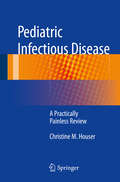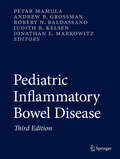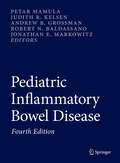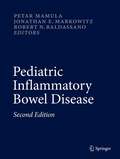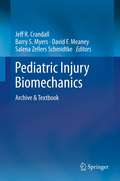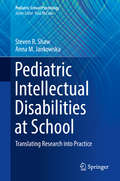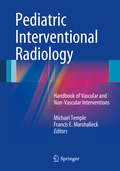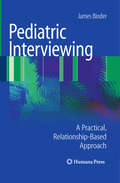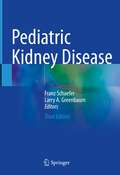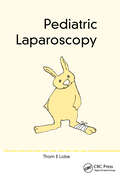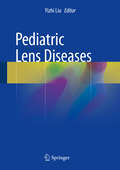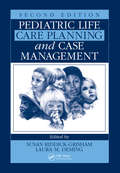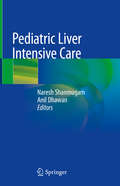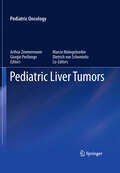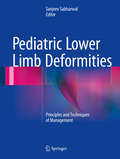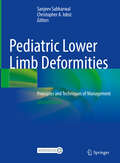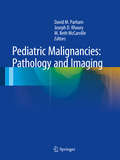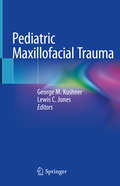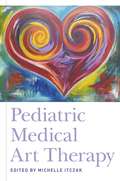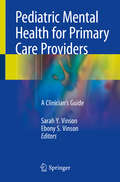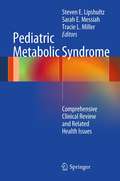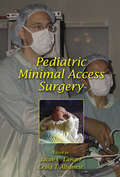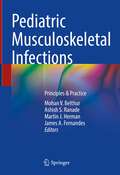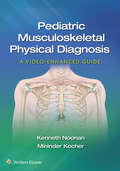- Table View
- List View
Pediatric Infectious Disease
by Christine M. HouserOften, information in review books can raise as many questions as it answers. This interferes with the study process, because the learner must either look up additional information or skip ahead without truly comprehending what he or she has read As an alternative, Pediatric Infectious Disease: A Practically Painless Review presents bite-size chunks of information that can be read and processed rapidly, helping learners to stay active while studying and to pick up new information the first time they read it This book's question and answer format allows for self-testing or study with a partner or a group. The format also facilitates dipping into the book during a few minutes of downtime at the hospital or office. Pediatric Infectious Disease: A Practically Painless Review is a quick and easy way to master tricky infectious disease topics and is suitable for those studying for the pediatric board exam, practicing physicians brushing up their skills, and any busy clinician who wants to learn more about this topic while on the go.
Pediatric Inflammatory Bowel Disease
by Petar Mamula Robert N. Baldassano Jonathan E. Markowitz Andrew B. Grossman Judith R. KelsenThe latest edition of this essential text provides a comprehensive overview of the unique pediatric issues of inflammatory bowel disease. Through new and thoroughly revised chapters, the volume features updates regarding pathogenesis, clinic features, and management, with an emphasis on recent understanding of pharmacokinetics and the utilization of cutting edge therapeutic monitoring to maximize efficacy of medical management. The new edition also highlights newer, recently approved drugs, emerging therapies, and the most recent recommendations regarding post-operative management for patients who ultimately require surgery. Written by experts in the field, Pediatric Inflammatory Bowel Disease, Third Edition is a valuable resource for both pediatric and adult gastroenterologists involved in the care of children with inflammatory bowel disease.
Pediatric Inflammatory Bowel Disease
by Petar Mamula Robert N. Baldassano Jonathan E. Markowitz Andrew B. Grossman Judith R. KelsenThe latest edition of this essential text provides a comprehensive overview of the unique pediatric issues of inflammatory bowel disease. Through new and thoroughly revised chapters, the volume features updates on all aspects of etiology, diagnosis, and treatment, with an emphasis on recent understanding of pharmacokinetics and the utilization of cutting edge therapeutic monitoring to maximize efficacy of medical management. The new edition also highlights newer, recently approved drugs, emerging therapies, and the most recent recommendations regarding post-operative management for patients who ultimately require surgery. Written by experts in the field, Pediatric Inflammatory Bowel Disease, Fourth Edition is a valuable resource for both pediatric and adult gastroenterologists involved in the care of children with inflammatory bowel disease.
Pediatric Inflammatory Bowel Disease
by Petar Mamula Robert N. Baldassano Jonathan E. MarkowitzPediatric Inflammatory Bowel Disease, Second Edition provides an essential reference with an emphasis on the unique pediatric issues of IBD. Chapters focus on complications of IBD specific to children and adolescents. Treatment recommendations are based on the latest clinical research available. The textbook also presents sections dedicated to the aspects of participation in clinical research unique to children and adolescents and the complicated yet vital process of successfully transitioning a patient from a pediatric to adult specialist. Controversies in pediatric IBD care such as the off-label use of medications are also covered. The format incorporates multiple tables, graphs, and figures to improve readability and make for an efficient reference for clinicians to use. Thoroughly revised and updated from the first edition, the volumes includes new therapies that are currently being used or tested for treatment of IBD, important areas regarding incidence and prevalence, immunization and response to vaccine administration as well as advancements in our understanding of growth and development with particular to the use of growth hormone therapy. Other new areas covered include important topics of complementary and alternative medicine use in IBD, immunization, and liver disease in IBD. Pediatric Inflammatory Bowel Disease, Second Edition is a valuable resource for pediatric gastroenterologists as well as adult gastroenterologists.
Pediatric Injury Biomechanics
by Barry S. Myers Jeff R. Crandall Salena Zellers Schmidtke David F. MeaneyPediatric Injury Biomechanics: Archive and Textbook consolidates and describes the current state of the art in pediatric injury biomechanics research in the automotive crash environment. Written by the most respected scientists in the field, the objective of this ground-breaking project is to provide a comprehensive archive and analysis of pediatric injury biomechanics research; to be the go-to reference for the epidemiology of motor vehicle related childhood injury data, pediatric anthropometry, pediatric biomechanical properties, tissue tolerance, and computational models. This book provides essential information needed by researchers working in the field of pediatric injury including those involved in rulemaking activities, injury criteria development, child dummy development, and child injury interventions development. In addition to the text, a companion archive will include valuable information and tools to assist in the identification of gaps in research and future research directions.This living document will be regularly updated with current research and advancements in pediatric injury biomechanics.
Pediatric Intellectual Disabilities at School: Translating Research into Practice (Pediatric School Psychology)
by Steven R. Shaw Anna M. JankowskaThis book synthesizes the most current evidence-based research and practices on prevention, assessment, intervention, and treatment of pediatric intellectual developmental disabilities. It provides a broad empirical framework for innovative practices and discusses their possible impact on children’s future development, ability to learn, social skills, and quality of life. The book highlights important findings in cognitive and behavioral development for children with such disorders as 22q13 Deletion syndrome (i.e., Phelan McDermid syndrome), Prader-Willi syndrome, Williams syndrome, and sex chromosome disorders (e.g., Klinefelter syndrome) – children often considered untestable, unteachable, and unknowable. In addition, the book includes case studies that emphasize a team approach with physicians, families, school psychologists, and teachers for providing quality research-based psychological, educational, and mental health services. Topics featured in this book include:Up-to-date findings on the causes and symptoms of intellectual disability disorders.Common medical treatments for children with intellectual disabilities.Therapeutic interventions for children with intellectual disabilities.Psychoeducational assessment practices for children requiring special education assistance.Future directions to support people with intellectual disabilities. Pediatric Intellectual Disabilities at School is a must-have resource for researchers, graduate students, and other professionals in child and school psychology, psychiatry, social work, special and general education, public health, and counseling.
Pediatric Interventional Radiology
by Michael Temple Francis E. MarshalleckThe introductory section of the book will highlight the unique elements of pediatric practice that are necessary to provide safe patient care. The remainder of the book will discuss all major vascular and non-vascular PIR procedures. The organization will be procedure specific with secondary area classification. The procedural chapters will be organized using a standard format to make it easier for readers to find information. The chapters will contain introductory descriptions of disease processes, indications for intervention, technical information about the procedures and post procedure care. Area specific procedural details will then be discussed. Within each chapter images, illustrations and tables will provide the quick access to the "What You Need to Know" information such as a list of the size/age appropriate equipment that is commonly used to perform procedures.
Pediatric Interventional Radiology.
by Richard Towbin Kevin BaskinThe emerging specialty of pediatric interventional radiology uses a variety of intravascular techniques to manage a wide range of childhood conditions, including cerebrovascular, soft-tissue, bone and joint, oncologic, gastrointestinal, venous, urologic, pulmonary, trauma, and hepatobiliary disorders. It has pioneered the use of several new radiologic techniques, e.g. the use of high-end ultrasound as a guidance modality in the performance of multi-modality procedures. Comprehensively covering the field, this volume highlights safe practice and features the diversity of problems for which treatment falls within the scope of this specialty. Over 700 illustrations, including high-quality radiographs and intraoperative photographs, give the reader an extensive insight into these conditions and procedures. Essential reading for pediatric interventional radiologists and trainees in pediatric and interventional radiology, this book will also be a useful reference for practitioners who treat childhood illnesses, and those who perform procedures such as central venous access, biopsy, and drainage in children. Extensive radiographs and photographs clearly illustrate the problems and procedures the reader is likely to encounter One of the first comprehensive texts covering this relatively new field Edited by leading authorities in the field, including one of its founders
Pediatric Interviewing
by James BinderThe evidence is extensive. Good communication has clear benefits for the clinician. Clinicians who interview well have a number of advantages, including the capability of gathering a full data base and of interviewing efficiently. Easy-to-read, compelling, and comprehensive in coverage, Pediatric Interviewing: A Practical, Relationship-Based Approach outlines effective strategies for interviewing parents and children efficiently. Topics covered include engaging patients and families, efficiently and smoothly obtaining a history of present illness and making a good differential diagnosis, uncovering hidden agendas, collaborative discussion in diagnosis and treatment, practicing family oriented care, taking a full social history, and all other aspects of carrying out the pediatric interview. Offering clear, practical tips and a wide range of targeted case examples, this invaluable title emphasizes the importance of combining the biological and psychological aspects of patient care seamlessly. Most important, Pediatric Interviewing: A Practical, Relationship-Based Approach is based on relationship theory, the underlying foundation of successful clinical interviewing and a major determinant of optimal diagnosis, treatment, and health outcomes. Pediatric Interviewing: A Practical, Relationship-Based Approach is an indispensable guide for all clinicians engaged in the care of children and adolescents.
Pediatric Kidney Disease
by Franz Schaefer Larry A. GreenbaumThe extensively revised third edition of this text offers an in-depth practical guide to clinical conditions encountered in pediatric nephrology. Extensively updated disease-specific chapters offer detailed coverage of relevant basic science, diagnostic work-up, laboratory evaluation methods, appropriate management options and potential complications. Topics covered include disorders of renal development, glomerular disorders, the kidney and systemic disease, renal tubular disorders, tubulointerstitial disease, urinary tract disorders, acute kidney injury, chronic kidney disease, dialysis, kidney transplantation and hypertension. Information is also provided on important related issues, including the genetic origins of diseases, the role of complement in the pathogenesis of kidney disease, and pharmacological aspects related to the kidney. Pediatric Kidney Disease comprehensively reviews a range of clinical conditions encountered in pediatric nephrology, assisting the reader to develop their skills and improve their clinical decision-making. It is a vital resource for trainees and practicing clinicians alike and a useful reference for those preparing for pediatric nephrology board examinations.
Pediatric Laparoscopy
by Thom E LobeSince pediatric surgeons can and do perform nearly every major pediatric surgical procedure laparoscopically, and since many of the approaches have evolved some over the years—past the learning curve—into cost effective operations that rarely take extra time to perform, or in some cases save time, it is worthwhile reviewing our current practices. This book, then, serves as both an update of current practices and as a manual for how to approach the most common of the pediatric disorders using laparoscopic techniques. It covers the basics of anesthesia, instrumentation and ergonomics and then reviews many of the more commonly performed laparoscopic and thoracoscopic pediatric procedures, including a review of fetal work. While any book written about such a rapidly evolving technique may miss some of the very newest twists and modifications of technique, it is our hope that most of the contents will serve the readers as a reference for years to come as they care for children with common pediatric surgical problems.
Pediatric Lens Diseases
by Yizhi LiuThis book focuses on disorders of the lens, which are a major cause of blindness in children. During development, children's eyes have unique physiological and structural characteristics, such as an immature blood-aqueous barrier, which presents considerable challenges for ophthalmologists involved in the diagnosis and treatment of pediatric lens disorders. Throughout the book, the pathology, examination, anesthesia, surgical treatment and nursing care of pediatric lens disorders are discussed in detail. It not only presents diverse pictures and images from clinical practice, it also includes the latest findings in the field. It will be of interest to ophthalmologists and paediatricians looking to improve the diagnosis and treatment of pediatric lens disorders and provide a valuable reference resource for all those involved in ophthalmic clinical practice, teaching and research.
Pediatric Life Care Planning and Case Management
by Kate M. Grady Andrew M. Severn Paul R. EldridgePediatric Life Care Planning and Case Management provides a comprehensive and unique reference that goes beyond the clinical discussion to include legal and financial aspects, life expectancy data, and assistive technology. It also includes case samples of actual plans related to specific conditions. The book is divided into five parts: Normal Grow
Pediatric Liver Intensive Care
by Anil Dhawan Naresh ShanmugamAcute management of children with liver disease and liver transplantation has rapidly evolved over the last two decades due to worldwide availability of complex liver surgery and liver transplantation. This book edited by Prof Dhawan and Dr Shanmugam, who have hands on experience in managing children with complex liver disease, its complications and liver transplant recepients, provides to a very practical approach to all the team members involved in paediatric transplantation like ; Hepatologists, anaesthetists, surgeons, intensivists, transplant coordinators, nurses and trainees at all levels and specialities. Topics covered include management of common liver problems, liver based metabolic disorders and peri-operative care protocols in paediatric liver transplantation. It also provides up to date information on drug dosage and infusion calculations for common drugs used in liver disease.
Pediatric Liver Tumors
by Arthur Zimmermann Dietrich Von Schweinitz Giorgio Perilongo Marcio MalogolowkinThe field of liver tumors in children has seen tremendous therapeutic advances over recent years. This has been achieved through a much better understanding of the biology of disease, improved diagnostic procedures, refined methods of pretreatment tumor staging, the implementation of highly efficient chemotherapy and surgery, detailed monitoring of toxicity, and careful follow-up strategies. International controlled trials have played a key role in these advances, and many leading figures in the trials are among the editors and authors of this book. Their principal goal in Hepatic Tumors in Children is to provide the reader with a complete update on this complex and rapidly evolving field. All aspects of an impressive success story are covered, disclosing how the outcome of a previously devastating disease has been so dramatically improved. This book will prove essential reading for all who are involved in the care of children with liver tumors.
Pediatric Lower Limb Deformities
by Sanjeev SabharwalComprehensive and generously illustrated, this text highlights both general principles and specific strategies for managing the spectrum of pediatric lower limb deformities. It is divided thematically into five sections, though any chapter can stand on its own to guide the clinician in specific situations. Part I covers general principles and techniques, including etiology, clinical evaluation, imaging as well as different surgical methods. Part II, covering related concepts and management options, discusses soft tissue contractures, amputations and working in austere and resource-challenged settings. Underlying conditions comprise part III - specific metabolic, neuromuscular and tumor-related conditions, along with arthrogryposis, Osteogenesis Imperfecta and various skeletal dysplasias. Part IV presents congenital and developmental disorders, such as congenital femoral deficiency, hemimelias, tibial pseudoarthrosis and Blount disease, while part V rounds out the book with chapters on sequelae related to different etiologies and their treatment. Covering all aspects of the management of pediatric lower limb deformities and written by renowned experts in the field, this textbook will be an invaluable resource for orthopedic surgeons and trainees worldwide.
Pediatric Lower Limb Deformities: Principles and Techniques of Management
by Sanjeev Sabharwal Christopher A. IobstNow in a completely revised and updated second edition, this comprehensive and generously illustrated text highlights both general principles and specific strategies for managing the spectrum of pediatric lower limb deformities. It is divided thematically into five sections, though any chapter can stand on its own to guide the clinician in specific situations. Part I covers general principles and techniques, including etiology, clinical evaluation, imaging as well as different surgical methods. Part II, covering related concepts and management options, discusses soft tissue contractures, amputations and working in austere and resource-challenged settings. Underlying conditions comprise Part III – specific metabolic, neuromuscular and tumor-related conditions, along with arthrogryposis, osteogenesis imperfecta and various skeletal dysplasias. Part IV presents congenital and developmental disorders, such as congenital femoral deficiency, hemimelias, tibial pseudoarthrosis and Blount disease, while Part V rounds out the book with chapters on sequelae related to different etiologies and their treatment.New to this edition is the inclusion of invited commentary from additional experts, adding further context and clinical pearls. Additionally, ten new chapters have been added, including some that are completely rewritten by different authors and other chapters that cover new themes such as patient reported outcome measures, setting up a limb deformity practice, pin site care and management of bone defects.Covering all aspects of the management of pediatric lower limb deformities in different practice settings, and written by internationally renowned experts in the field, this new edition of Pediatric Lower Limb Deformities continues to be an invaluable resource for orthopedic surgeons and trainees worldwide.
Pediatric Malignancies: Pathology and Imaging
by David M. Parham Joseph D. Khoury M. Beth MccarvillePediatric tumors comprise a unique set of diseases that may pose diagnostic challenges to pathologists, oncologists, and pediatricians. Pediatric Tumor Pathology: A Practical Approach serves as a state-of-the-art reference for understanding the fundamental biology and diagnostic aspects of pediatric tumors. This volume stands apart from other books covering pediatric neoplasia by providing an in-depth analysis of the pathogenetic and diagnostic aspects of the most commonly encountered tumors. The volume covers the new advances in our understanding of the molecular processes underlying a number of pediatric tumors and the novel, sophisticated diagnostic tools that have now become an integral part of practice standards. Pediatric Tumor Pathology: A Practical Approach will be of great value for many practicing clinicians and pathologists for characterizing and diagnosing childhood tumors. Oncologists, radiologists, surgeons and pediatricians will also find this book a unique and valuable resource for understanding the biological and diagnostic aspects of pediatric tumor pathology.
Pediatric Maxillofacial Trauma
by George M. Kushner Lewis C. JonesThis book aims to assist the reader in navigating the potentially complex decision-making process involved in selecting the most appropriate intervention for each particular scenario that may be encountered by the practitioner or surgeon in the growing patient with facial trauma. Among the topics covered are the initial management of both soft and bony trauma, including different types of fracture, as well as the management of complications and revision surgery. The discerning practitioner will learn how to provide the appropriate intervention at the appropriate time, by taking into account skeletal growth when matching techniques to the injuries more common in the skeletally immature patient. It is also emphasized that in some cases, no intervention is advisable owing to the possibility of damaging growth centers or introducing additional scar tissue that may impede future growth. Pediatric Maxillofacial Trauma will provide key knowledge for surgeons treating growing patients, ensuring that their decisions to operate or delay intervention are evidence based.
Pediatric Medical Art Therapy
by Tracy Councill Kayleigh Orr Andrea Davis Nana Zhvitiashvili Julie Gant Anna Moore Megan Belcher Abbien Crowley Ciucci Josephine Mahoney Aimee O'Neill Kristen CatchpoleArt therapists have an essential part to play in supporting children and their families when a child is undergoing medical treatment. The art therapists who contribute to this book offer their experience of working in medical environments and creating hospital art therapy programs for working with children and young people. Readers will find interventions and techniques, along with program development ideas and diverse approaches to work with patients. Chapters also cover different diagnoses and areas of healthcare, such as oncology, chronic illness and burns. The challenges and opportunities for art therapy in working with terminal illness and bereavement are also addressed. Pediatric Medical Art Therapy delineates the essential considerations and lessons for the art therapist who joins the medical journeys of children and their families, and emphasises the importance of this unique role.
Pediatric Mental Health for Primary Care Providers: A Clinician's Guide
by Sarah Y. Vinson Ebony S. VinsonThe purpose of this book is to provide a children’s mental health resource tailored to the needs of physicians working with children. There are currently no such texts, despite the fact that there are patient care, healthcare systems, and workforce factors that indicate a strong need for such a resource. Approximately 1 in 5 children are diagnosed with a mental illness by the age of 18. Additionally, mental health conditions, including Attention Deficit Hyperactivity Disorder, are consistently among the most common chronic conditions in pediatric clinical populations. Delays in both diagnosis and treatment increase the morbidity associated with these conditions. These delays expose the child to negative ramifications of his/her illness and can impact rates of poor academic performance, substance use disorders and criminal justice system involvement – potentially impacting long-term life trajectories. Early identification of mental illness and appropriate intervention is critical to the healthy development of youth, though physicians in primary care and pediatrics are seldom trained to detect and treat such illnesses. The importance of recognizing mental illness is reflected in practice guidelines for pediatric primary care providers as well as in how service delivery is being structured, but this does not offer in-depth clinical guidelines. Additionally, integrated care and medical home models include mental health as key components, though yet again physicians are often not trained to work with these models. While clearly indicated clinically, these requirements do not come with significant increases in reimbursement and are added to an already demanding schedule. Increasingly, providers are also expected to use evidence based screening instruments without exposure to this body of literature. Some guidance on using those instruments in context will help them to use those tools more effectively. Finally, primary care providers and even some adult psychiatrists and psychologists are operating in a healthcare system with a severe, nationwide shortage of child and adolescent psychiatrists and mental healthcare providers. While a text certainly cannot single-handedly compensate for such a workforce shortage, it could potentially help to mitigate the negative impact on patients by facilitating early identification and treatment in the primary care setting. Additionally, with more effective treatment in pediatric settings, less complex cases may be addressed before specialty care is needed, and the expertise of child and adolescent psychiatrists can be more effectively used for more complex cases.Pediatric Psychiatry in Primary Care is the ultimate resource for clinicians working with children, including pediatricians, family physicians, general psychiatrists, psychologists, early career child psychiatrists, social workers, nurses, school counselors, and all clinical professionals who may encounter children struggling with psychiatric disorders.
Pediatric Metabolic Syndrome
by Sarah E. Messiah Steven E. Lipshultz Tracie L. MillerIn just under three decades, the world has witnessed an enormous rise in obesity with a parallel growth in cardiometabolic disease risk factors characterized by insulin resistance, dyslipidemia, and hypertension, together known as the metabolic syndrome - conditions previously unheard of in children and adolescents. During this time, we have little knowledge of the global and cumulative detrimental health effects of childhood obesity. As obese children age, not only will their health be negatively affected, but infertility and pregnancy complications associated with the metabolic syndrome will affect generations to come. The work force will undoubtedly be affected because of increased sick days and decreased work productivity. Identifying children and adolescents at the earliest stages of chronic disease onset should be the goal of clinical practice, yet there is no clear guidance for defining the risk of metabolic syndrome or appropriate risk-factor thresholds in these groups. If children are identified early in the disease process, lifestyle and clinical interventions can be instituted when they are potentially more effective. Pediatric Metabolic Syndrome: Comprehensive Clinical Review and Related Health Issues approaches the pediatric metabolic syndrome by elucidating its effects on specific organ systems and by considering the problem through understanding the social, psychological and economic consequences of it. The Editors have recruited an invited group of esteemed experts in the field to provide the most timely and informative approaches on how to deal with this health crisis. Through educating our practitioners, our future researchers, our health and community organizations, our legislators and our families and children, we have the best chance at improving the health trajectory of the next generation.
Pediatric Minimal Access Surgery
by Jacob C. Langer Craig T. AlbaneseThis authoritative guide reviews the evoloving evidence-based literature for a wide variety of procedures and techniques in pediatric minimal access surgery (MAS)-providing expertly-written chapters that cover the techniques specific to a broad range of diseases, as well as current advances in urology, neurosurgery, and spinal and cardiac surgery.
Pediatric Musculoskeletal Infections: Principles & Practice
by Martin J. Herman Mohan V. Belthur Ashish S. Ranade James A. FernandesPediatric musculoskeletal infections are common globally and represent about 1-2% of all pediatric hospital admissions in the developed world and about 10-20% of admissions in the developing countries. If untreated or treated inadequately, pediatric bone and joint infections can cause significant mortality and morbidity. The functional and economic burden to the family and community at large also presents a significant public health problem.This book serves as an evidence-based, comprehensive review of the current concepts for the early diagnosis and management of pediatric musculoskeletal infections. Currently, there are no comprehensive, easily accessible books on this topic. This first of its kind book also uses a multidisciplinary and global approach by including contributions from editors and authors worldwide. The long-term goal of this text is to help improve the quality of care provided to children with musculoskeletal infections improve patient safety, reduce the cost of care, and add value to the care provided to these children and thus reduce the economic burden.Broken up into five sections, the first part of this text covers the epidemiology, microbiology, pathological consequences, antibiotic therapies, systemic effects, and imaging modalities of pediatric musculoskeletal infections. Section two takes a detailed look at acute pediatric musculoskeletal infections. Infections discussed in this section include acute hematogenous osteomyelitis, septic arthritis, pyomyositis, complex musculoskeletal infections, musculoskeletal infections in the neonate and acute surgical site infection after pediatric orthopedic surgery. Section three focuses on chronic osteomyelitis and its sequelae. Section four examines anatomic region-specific considerations in musculoskeletal infections. The topics that are expanded upon are epiphyseal osteomyelitis, Pediatric hand and foot infections, tuberculosis of the axial and the appendicular skeleton, and non-tuberculous infections of the spine. Finally, the fifth section includes an overview of less common musculoskeletal conditions such as, fungal infections, brucellosis, hydatid disease, gas gangrene, viral musculoskeletal infection and meningococcal infections.Written by experts in the field, Pediatric Musculoskeletal Infections: Principles and Practice serves as an easily accessible resource for a global audience of healthcare providers from multiple disciplines to aid them in making informed decisions while managing pediatric bone and joint infections. Paediatricians, orthopedic surgeons, infectious disease physicians, radiologists, pathologists, family physicians and any other healthcare providers involved in the care of children with musculoskeletal infections will find immense value in this reference as will medical students, residents and fellows.
Pediatric Musculoskeletal Physical Diagnosis: A Video-Enhanced Guide
by Mininder Kocher Kenneth NoonanMusculoskeletal complaints represent a large percentage of cases seen by pediatricians, family physicians, and other first-line clinicians who work with children and adolescents. Pediatric Musculoskeletal Physical Diagnosis: A Video-Enhanced Guide helps health care practitioners arrive at an accurate diagnosis and determine the need for a referral. Written by leaders in pediatric orthopaedics, this practical guide is a comprehensive, multimedia resource covering the physical examination and the next steps to diagnosis of disorders of the growing musculoskeletal system. This is the tablet version which does not include access to the videos mentioned in the text.
